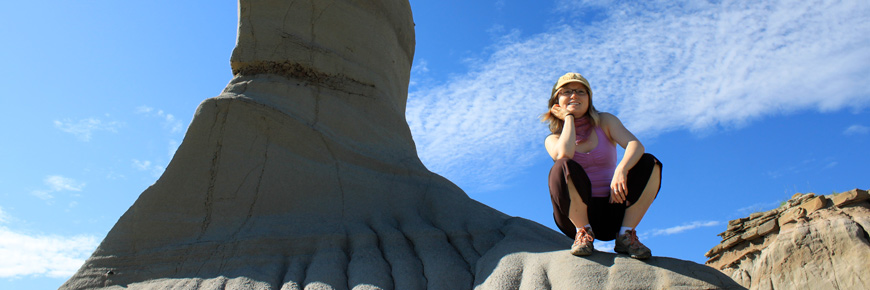
Dinosaur Provincial Park
Alberta
Date of Inscription: 1979 (ext. 10 July 1992)
Seventy-five million years ago, what is now eastern Alberta was a low-lying coastal plain at the edge of a large shallow sea. The climate was subtropical, similar to northern Florida today. Countless creatures flourished there - fish, amphibians, reptiles, birds, primitive mammals and about 35 species of dinosaur. When some of these animals died, they lay in river channels and mud flats so their bones were buried in new layers of sand and mud. Over time, a combination of pressure, lack of oxygen and deposition of minerals produced fossils - impressions of the bones, teeth and skin of those creatures that once roamed ancient Alberta. Over more time, new layers of sediments covered the fossils and preserved them.
Justification of outstanding universal value
Dinosaur Provincial Park was designated as a World Heritage site by UNESCO’s World Heritage Committee under the following criteria:
Criterion (vii): Dinosaur Provincial Park is an outstanding example of major geological processes and fluvial erosion patterns in semi-arid steppes. These "badlands" stretch along 24 kilometers of high quality and virtually undisturbed riparian habitat, presenting a landscape of stark, but exceptional natural beauty.
Criterion (viii): The property is outstanding in the number and variety of high quality specimens representing every known group of Cretaceous dinosaurs. The diversity affords excellent opportunities for paleontology that is both comparative and chronological. Over 300 specimens from the Oldman Formation in the park including more than 150 complete skeletons now reside in more than 30 major museums.
Full description
And so it was until the end of the latest Ice Age, 13,000 years ago, a mere wink in geological time, when glacial ice scraped off the upper layers of rock. Huge volumes of meltwater carved deep into the soft sandstone and mudstone strata, exposing the fossil-bearing sediments and, in the process, creating the Red Deer River Valley. Its haunting hoodoos, isolated mesas and low-lying coulees are at the heart of Alberta’s badlands and contain the greatest concentration of Late Cretaceous dinosaur fossils yet found on Earth.
More than 300 first-quality dinosaur skeletons have been pulled from a 27-kilometre stretch along the Red Deer River since digging began there in the 1880s. And dozens of these now grace museum space in 30 cities around the world. Since 1985 the largest collection of treasures from the park has been housed in the Royal Tyrrell Museum of Palaeontology, in Drumheller, a two-hour drive northwest of the park.
More Information
World Heritage Centre:
World Heritage - Dinosaur Provincial Park
Alberta Tourism, Parks and Recreation Web site:
Related links
- Anticosti, Quebec
- Tr’ondëk-Klondike, Yukon
- Writing-on-Stone / Áísínai’pi
- L’Anse aux Meadows National Historic Site
- Nahanni National Park Reserve
- Kluane / Wrangell-St.Elias / Glacier Bay /...
- Head-Smashed-In Buffalo Jump
- SG̱ang Gwaay
- Wood Buffalo National Park
- Canadian Rocky Mountain Parks
- Historic District of Old Québec
- Gros Morne National Park
- Old Town Lunenburg
- Waterton-Glacier International Peace Park
- Miguasha National Park
- Rideau Canal
- Joggins Fossil Cliffs
- Landscape of Grand Pré
- Red Bay Basque Whaling Station
- Mistaken Point
- Pimachiowin Aki
- Date modified :